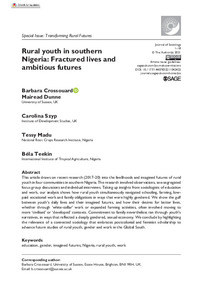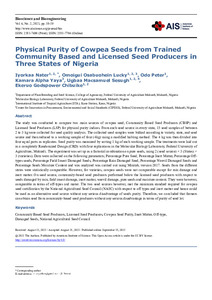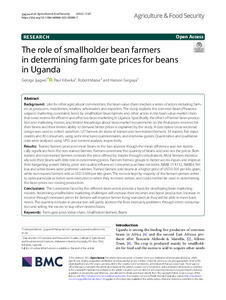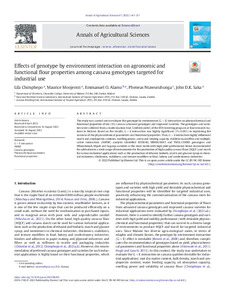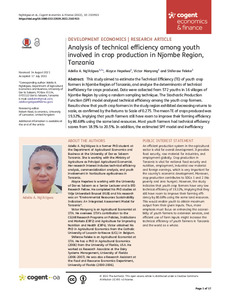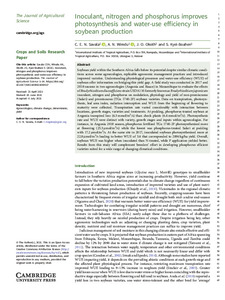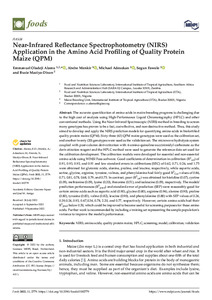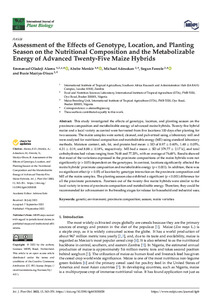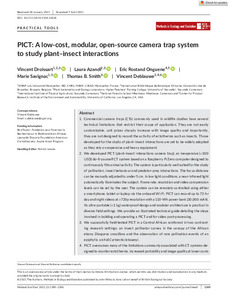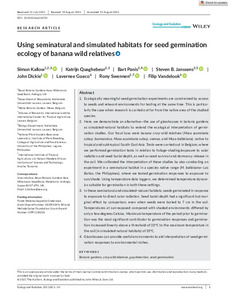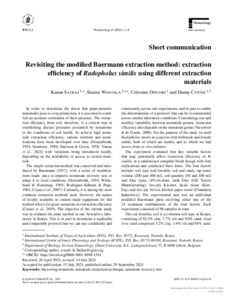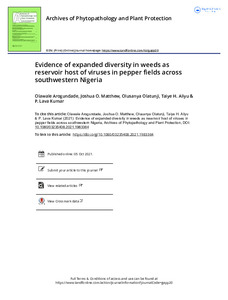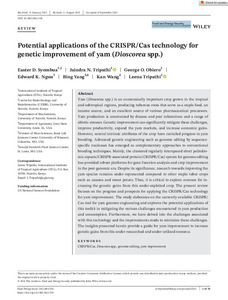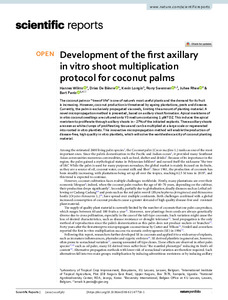Welcome to the International Institute of Tropical Agriculture Research Repository
Journal and Journal Articles: Recent submissions
Now showing items 421-440 of 5157
-
Rural youth in southern Nigeria: fractured lives and ambitious futures
(2021)This article draws on recent research (2017–20) into the livelihoods and imagined futures of rural youth in four communities in southern Nigeria. The research involved observations, sex-segregated focus group discussions and individual interviews. Taking up insights from sociologists of education and work, our analysis shows how rural youth simultaneously navigated schooling, farming, low-paid vocational work and family obligations in ways that were highly gendered. We show the gulf between youth’s ... -
Physical purity of cowpea seeds from trained community based and licensed seed producers in three states of Nigeria
(2021)The study was conducted to compare two main sources of cowpea seed, Community Based Seed Producers (CBSP) and Licensed Seed Producers (LSP) for physical purity indices. From each seed source in every state, 15 seed samples of between 2 to 3 kg were collected for seed quality analysis. The collected seed samples were bulked according to variety, state, and seed source and then reduced to a working sample of four (4kg) using a modified halving method. The 4 kg was then divided into four equal parts ... -
The role of smallholder bean farmers in determining farm gate prices for beans in Uganda
(2022-09-07)Like for other agricultural commodities, the bean value chain involves a series of actors including; farmers as producers, middlemen, retailers, wholesalers and exporters. The study explains the common bean (Phaseolus vulgaris) marketing constraints faced by smallholder bean farmers and other actors in the bean value market chain that need redress for efficient and effective bean marketing in Uganda. Specifically, the effect of farmer bean production and marketing modes, and limited knowledge about ... -
Effects of genotype by environment interaction on agronomic and functional flour properties among cassava genotypes targeted for industrial use
(2022-12)The study was carried out to evaluate the genotype by environment (G × E) interaction on physicochemical and functional properties of ten (10) cassava advanced genotypes and improved varieties. The genotypes and varieties were collected from a multi-location trial (Uniform yield) of the IITA breeding program at four research stations in Malawi. Based on the results, G × E interaction was highly significant (P ≤ 0.001) in explaining the variance of the physicochemical parameters and functional ... -
Analysis of technical efficiency among youth involved in crop production in Njombe Region, Tanzania
(2022-09-02)This study aimed to estimate the Technical Efficiency (TE) of youth crop farmers in Njombe Region of Tanzania, and analyze the determinants of technical inefficiency for crops produced. Data were collected from 572 youths in 16 villages of Njombe Region by using a random sampling technique. The Stochastic Production Function (SPF) model analysed technical efficiency among the youth crop farmers. Results show that youth crop farmers in the study region exhibited decreasing returns to scale, as ... -
Inoculant, nitrogen and phosphorus improves photosynthesis and water-use efficiency in soybean production
(2021)Soybean yield within the Southern Africa falls below its potential despite similar climatic conditions across some agroecologies, replicable agronomic management practices and introduced improved varieties. Understanding physiological processes and water-use efficiency (WUE) of soybean offer information on bridging this yield gap. A field study was conducted in 2017 and 2018 seasons in two agroecologies (Angonia and Ruace) in Mozambique to evaluate the effects of Bradyrhizobium diazoefficiens ... -
The future of farming: Who will produce our food?
(2021)Achieving SDG2 (zero hunger) in a situation of rapid global population growth requires a continued focus on food production. Farming not merely needs to sustainably produce nutritious diets, but should also provide livelihoods for farmers, while retaining natural ecosystems and services. Rather than focusing on production principles, this article explores the interrelations between farms and farming systems in the global food system. Evaluating farming systems around the world, we reveal a bewildering ... -
Near-Infrared Reflectance Spectrophotometry (NIRS) application in the amino acid profiling of Quality Protein Maize (QPM)
(2022-09-09)The accurate quantification of amino acids in maize breeding programs is challenging due to the high cost of analysis using High-Performance Liquid Chromatography (HPLC) and other conventional methods. Using the Near-Infrared Spectroscopic (NIRS) method in breeding to screen many genotypes has proven to be a fast, cost-effective, and non-destructive method. Thus, this study aimed to develop and apply the NIRS prediction models for quantifying amino acids in biofortified quality protein maize (QPM). ... -
Assessment of the effects of genotype, location, and planting season on the nutritional composition and the metabolizable energy of advanced twenty-five maize hybrids
(2022-09-09)This study investigated the effects of genotype, location, and planting season on the proximate composition and metabolizable energy of advanced maize hybrids. Twenty-five hybrid maize and a local variety as control were harvested from five locations 100 days after planting for two seasons. The maize samples were sorted, cleaned, and pulverized using a laboratory mill and were analyzed for nutritional composition and metabolizable energy (ME) using standard laboratory methods. Moisture content, ... -
PICT: A low-cost, modular, open-source camera trap system to study plant–insect interactions
(2021)Commercial camera traps (CTs) commonly used in wildlife studies have several technical limitations that restrict their scope of application. They are not easily customizable, unit prices sharply increase with image quality and importantly, they are not designed to record the activity of ectotherms such as insects. Those developed for the study of plant–insect interactions are yet to be widely adopted as they rely on expensive and heavy equipment. We developed PICT (plant–insect interactions camera ... -
Genetic analysis of grain yield and resistance of extra-early-maturing maize inbreds to northern corn leaf blight
(2021)Maize (Zea mays L.) is a food security crop in sub-Saharan Africa (SSA). Incidence of northern corn leaf blight (NCLB), caused by Exserohilum turcicum, in lowlands of SSA during the past decade has caused 30–70% reduction in maize yield. This study (a) examined the combining abilities of extra-early maize (EEM) inbreds and classified them into heterotic groups; (b) elucidated gene action controlling resistance to NCLB; (c) assessed grain yield (GYLD) and yield stability of EEM hybrids underNCLB ... -
Using seminatural and simulated habitats for seed germination ecology of banana wild relatives
(2021-10-11)Ecologically meaningful seed germination experiments are constrained by access to seeds and relevant environments for testing at the same time. This is particularly the case when research is carried out far from the native area of the studied species. Here, we demonstrate an alternative—the use of glasshouses in botanic gardens as simulated-natural habitats to extend the ecological interpretation of germination studies. Our focal taxa were banana crop wild relatives (Musa acuminata subsp. burmannica, ... -
Trait profile of maize varieties preferred by farmers and value chain actors in northern Ghana
(2021-07-06)Plant breeders’ knowledge of precise traits preferred by variety users would accelerate varietal turnover and widen adoption of newly developed maize varieties in Ghana. The objective of this research was to provide empirical evidence of trait preferences of farmers and other actors in the maize value chain in northern Ghana, based on which research strategies for maize improvement could be formulated. Participatory rural appraisal was conducted in 2016 to determine key traits preferred by maize ... -
New sources and stability of resistance to aphids in cowpea germplasm across locations in Uganda
(2021)The cowpea aphid (Aphis craccivora Koch) is an economically important pest, whose feeding effects cause stunting, delayed flower initiation and yield reduction in cowpea (Vigna unguiculata L. Walp). Host plant resistance offers an alternative for controlling aphids; while simultaneously reducing reliance on chemical pesticides. The objective of this study was to evaluate a multi-parent advanced generation inter-cross (MAGIC) population of cowpea against aphids, across cowpea growing regions in ... -
Revisiting the modified Baermann extraction method: extraction efficiency of Radopholus similis using different extraction materials
(2021-09-29)In order to determine the threat that plant-parasitic nematodes pose to crop production, it is essential to establish an accurate estimation of their presence. The extraction efficiency from soil, therefore, is a critical step in establishing disease pressures presented by nematodes or the conditions of soil health. To achieve high nematode extraction efficiency, various methods and modifications have been developed over time (Oostenbrink, 1954; Seinhorst, 1956; Harrison & Green, 1976; Viaene et ... -
Diversity of nematodes on banana (Musa spp.) in Kenya linked to altitude and with a focus on the pathogenicity of Pratylenchus goodeyi
(2021-08-30)Summary Bananas (Musa spp.) are considered the most important fruit crop in Kenya, grown mostly by smallholder farmers. However, in the past two decades production has declined and has largely been attributed to plant pathogens, including plant-parasitic nematodes. To assess the understanding and awareness that banana farmers have of nematodes, a survey was conducted. The incidence, abundance and distribution of nematodes in relation to altitude were determined for different banana types on 180 ... -
Evidence of expanded diversity in weeds as reservoir host of viruses in pepper fields across southwestern Nigeria
(2021-10-05)This study aimed to investigate virus occurrence in weed species in the main pepper-growing areas in Southwest Nigeria. The weed samples collected from pepper farms were identified and subjected to Antigen-Coated Plate Enzyme-Linked Immunosorbent Assay using antibodies specific eight different viruses. Results showed that the Weed species collected contain 17 families, 33 genera and 36 plant species of which 83.33% of the plant species tested positive to one or more plant viruses. The results ... -
First report of banana bunchy top virus in banana and plantain (Musa spp.) in Tanzania
(2022-04)Banana (including plantain; Musa spp.) is an important vegetatively propagated food staple grown as a semi-perennial crop in fields and backyard gardens in Tanzania. Banana bunchy top disease (BBTD), caused by the banana bunchy top virus (BBTV, genus Babuvirus), is the most economically important viral disease of banana, infection of which results in severe stunting and reduction in fruit production by 90-100% within two seasons. The virus is spread by the banana aphid, Pentalonia nigronervosa, ... -
Potential applications of the CRISPR/Cas technology for genetic improvement of yam (Dioscorea spp.)
(2021-09)Yam (Dioscorea spp.) is an economically important crop grown in the tropical and subtropical regions, producing tuberous roots that serve as a staple food, an income source, and an excellent source of various pharmaceutical precursors. Yam production is constrained by disease and pest infestations and a range of abiotic stresses. Genetic improvement can significantly mitigate these challenges, improve productivity, expand the yam markets, and increase economic gains. However, several intrinsic ... -
Development of the first axillary in vitro shoot multiplication protocol for coconut palms
(2021)The coconut palm or “tree of life” is one of nature’s most useful plants and the demand for its fruit is increasing. However, coconut production is threatened by ageing plantations, pests and diseases. Currently, the palm is exclusively propagated via seeds, limiting the amount of planting material. A novel micropropagation method is presented, based on axillary shoot formation. Apical meristems of in vitro coconut seedlings are cultured onto Y3 medium containing 1 µM TDZ. This induces the apical ...

